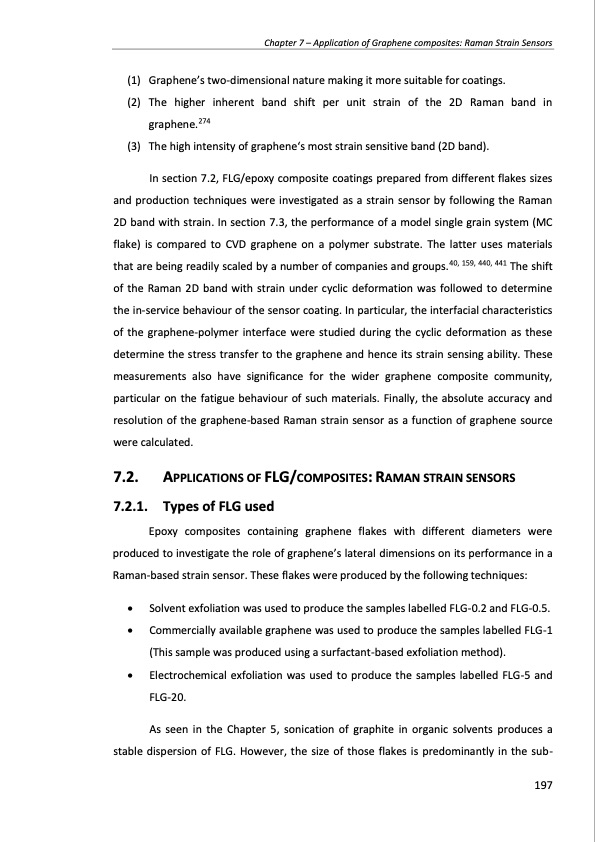PDF Publication Title:
Text from PDF Page: 197
Chapter 7 – Application of Graphene composites: Raman Strain Sensors (1) Graphene’s two-dimensional nature making it more suitable for coatings. (2) The higher inherent band shift per unit strain of the 2D Raman band in graphene.274 (3) The high intensity of graphene‘s most strain sensitive band (2D band). In section 7.2, FLG/epoxy composite coatings prepared from different flakes sizes and production techniques were investigated as a strain sensor by following the Raman 2D band with strain. In section 7.3, the performance of a model single grain system (MC flake) is compared to CVD graphene on a polymer substrate. The latter uses materials that are being readily scaled by a number of companies and groups.40, 159, 440, 441 The shift of the Raman 2D band with strain under cyclic deformation was followed to determine the in-service behaviour of the sensor coating. In particular, the interfacial characteristics of the graphene-polymer interface were studied during the cyclic deformation as these determine the stress transfer to the graphene and hence its strain sensing ability. These measurements also have significance for the wider graphene composite community, particular on the fatigue behaviour of such materials. Finally, the absolute accuracy and resolution of the graphene-based Raman strain sensor as a function of graphene source were calculated. 7.2. APPLICATIONS OF FLG/COMPOSITES: RAMAN STRAIN SENSORS 7.2.1. Types of FLG used Epoxy composites containing graphene flakes with different diameters were produced to investigate the role of graphene’s lateral dimensions on its performance in a Raman-based strain sensor. These flakes were produced by the following techniques: Solvent exfoliation was used to produce the samples labelled FLG-0.2 and FLG-0.5. Commercially available graphene was used to produce the samples labelled FLG-1 (This sample was produced using a surfactant-based exfoliation method). Electrochemical exfoliation was used to produce the samples labelled FLG-5 and FLG-20. As seen in the Chapter 5, sonication of graphite in organic solvents produces a stable dispersion of FLG. However, the size of those flakes is predominantly in the sub- 197PDF Image | PRODUCTION AND APPLICATIONS OF GRAPHENE AND ITS COMPOSITES

PDF Search Title:
PRODUCTION AND APPLICATIONS OF GRAPHENE AND ITS COMPOSITESOriginal File Name Searched:
graphene-production-applications.PDFDIY PDF Search: Google It | Yahoo | Bing
Salgenx Redox Flow Battery Technology: Power up your energy storage game with Salgenx Salt Water Battery. With its advanced technology, the flow battery provides reliable, scalable, and sustainable energy storage for utility-scale projects. Upgrade to a Salgenx flow battery today and take control of your energy future.
CONTACT TEL: 608-238-6001 Email: greg@infinityturbine.com (Standard Web Page)